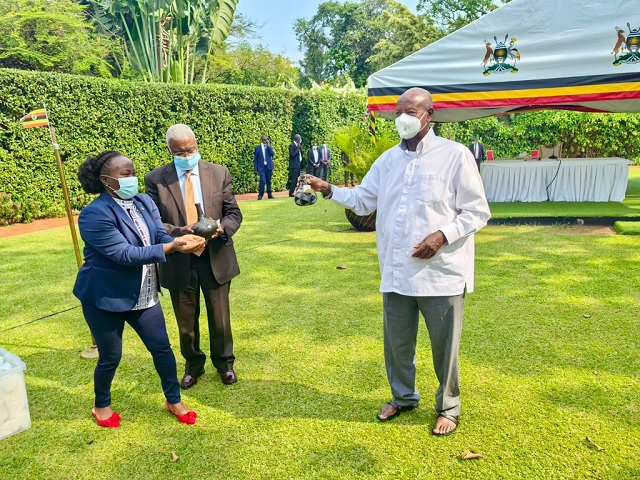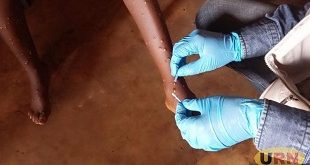
Kampala, Uganda | THE INDEPENDENT | President Yoweri Kaguta Museveni has welcomed the return of cultural artifacts from Britain that were taken during the colonial era.
A statement by the Presidential Press Unit notes that Museveni was happy that the return of the artifacts marks a profound moment in the history of Uganda.
The statement says that the news of the return of the artifacts was received by the President yesterday during the weekly Cabinet Meeting.
“These artifacts, taken from Uganda during the colonial era, have been a poignant reminder of the country’s rich cultural heritage that has long resided abroad. The Ministry of Tourism, Wildlife, and Antiquities expresses profound gratitude for the return of these invaluable pieces, eagerly anticipated since negotiations began in 2019. These artifacts, taken by British colonial administrators, missionaries, anthropologists, and soldiers during the 1890s and early 1900s, hold immense historical importance for Uganda and its people,” the statement reads in part.
It adds that the repatriation of these artifacts sets a precedent for future returns of historical objects acquired during colonial rule, as Uganda joins other African nations in reclaiming its cultural legacy.
“This endeavor is part of a broader effort to secure the cultural rights of Ugandans sustainably and preserve the country’s heritage for generations to come,” the statement says. It adds that the process of repatriating the artifacts began under the ‘Rethinking Uganda Museum’ project in 2016, supported by the University of Michigan and funded by the Andrew Mellon Foundation. Through collaborative efforts, two Ugandan curators were invited to select the artifacts to be repatriated in November 2022, a pivotal moment in the journey to bring these cultural treasures back to Uganda.
“These artifacts represent a tangible lhonoringanda’s past, awaiting their rightful place within the country’s cultural landscape. The return of these artifacts underscores a commitment to acknowledging and honouring Uganda’s history while othere ways for a brighter cultural future,” the statement reads in part. About two weeks ago, at least 39 different artifacts that included regalia and pottery from different parts of the country were returned to Uganda by Britain.
Last week, the University of Cambridge’s Museums and Botanic Grden (Museum of Archaeology and Anthropology )returned 39 artifacts. Among them, was a beautiful headdress from Lango taken to Cambridge in 1937. Thy also included pieces of backcloth retrieved from its stores. “The Ugandan barkcloths at MAA vary dramatically in size, with the smallest at 53cm x 16cm and the largest 459cm x 248cm” Upon unrolling, we noticed that in many instances the beater marks are still visible upon the barkcloth, sometimes forming intricate patterns. She wrote that due to their large size, many of the barkcloths are stored rolled onto acid-free cardboard tubes and hung from poles. “This protective technique avoids folding them and prevents creating new creases which can lead to permanent damage. To fully unroll the barkcloths, and to allow us to examine and document them, we moved from our desks to the floor, which had been prepared with conservation grade coverings to protect the objects.” Writes Emily Shorter, a Collections Assistant, the Museum of Archaeology & Anthropology.
’Our observational skills were useful as contextual information for the Ugandan barkcloth collection survives unevenly in the museum’s records, limiting what we know about their past. Between the late 19th century and mid-20th century, the collection at MAA slowly grew as a result of bequeathed and donated cloth from multiple sources” said Emily Shorter.
According to Professor Derek Peterson, the Cambridge Museum sent the artifacts to Uganda on a 3-year renewable loan. He said they expect that–within that period, the Ministry of Trade Wildlife and Antiquities will make a formal claim for a transfer of title. He explained that they agreed with the Uganda Museum on a long-term loan. “It’s a way to get the objects into Ugandans’ hands, to show what they can mean once they’re reintroduced in Uganda’s public life. It’s a prelude–legally–to a formal transfer of title” said Peterson on his X formerly Twitter handle.
“We all expect these objects to remain in Uganda, where they’ll teach future generations who visit the Uganda Museum about the cultural trauma and political dislocation of colonialism. Personally, I hope they’ll eventually become the core of a newly built national history exhibition” Said Peterson.
Britain which colonized Uganda and different countries in Africa and elsewhere, took away several priceless artifacts that in recent years it has started returning to their origins after relentless campaigning by activists.
******
URN
 The Independent Uganda: You get the Truth we Pay the Price
The Independent Uganda: You get the Truth we Pay the Price




Museveni is the wrong receiver of the stolen artifacts… because he’s part of them by extension….let the repatriated artifacts be returned to their respective regions from where they were stolen….by the time they were taken Uganda was not in existence but the cultural institutions existed and they still exist….by returning them to their mother institutions it will further inland tourism as tourists will be encouraged to move from place place in search of these treasures other than when they are placed in one location. Buganda needs its backcloth.
Nice point Kakyama.
On the point of bark cloth, so does Bunyoro and Toro. The British greedily harvested different samples and textures of bark cloth among other artifacts from the major kindgoms. The Kings have to receive them back in a more honourable ceremony.